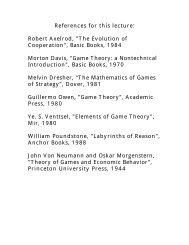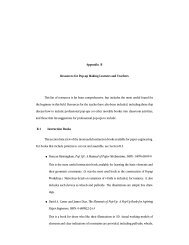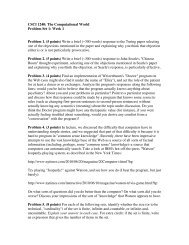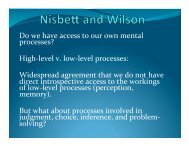A Conceptual Framework for Computer- Supported Collaborative ...
A Conceptual Framework for Computer- Supported Collaborative ...
A Conceptual Framework for Computer- Supported Collaborative ...
Create successful ePaper yourself
Turn your PDF publications into a flip-book with our unique Google optimized e-Paper software.
Table 1 describes three learning strategies with their respective strengths and<br />
weaknesses <strong>for</strong> workplace learning.<br />
Table 1: Multiple Learning Strategies<br />
Level Description Strengths Weaknesses<br />
Fix-It<br />
Level<br />
Reflect<br />
Level<br />
Tutorial<br />
Level<br />
fixes the problem by<br />
giving per<strong>for</strong>mance<br />
support without detailed<br />
understanding<br />
explores argumentative<br />
context <strong>for</strong> reflection<br />
(“reflection-in-action”)<br />
provides contextualized<br />
tutoring (not lecturing on<br />
unrelated issues)<br />
Communities of Interest<br />
keeps focus on<br />
task; learning does<br />
not delay work<br />
understanding of<br />
specific issues<br />
systematic<br />
presentation of a<br />
coherent body of<br />
knowledge<br />
creates little<br />
understanding<br />
piecemeal<br />
learning of<br />
(disconnected)<br />
issues<br />
substantial time<br />
requirements<br />
Working on systemic problems requires the collaboration and coordination of<br />
stakeholders from different communities of practice (CoP) [Wenger, 1998]. We<br />
define a community of interest (CoI) [Fischer, 2005] as a group of stakeholders<br />
brought together from different CoP, on the basis of a common concern or interest,<br />
to solve a particular complex design problem. In contrast to project teams, wherein<br />
employees are held together by a <strong>for</strong>mal contract such as a business project, CoI<br />
stakeholders are held together by a shared interest.<br />
CoIs are often more temporary than CoPs and can not rely on a shared social<br />
practice. Their raison d'être is a common interest in the framing and resolution of a<br />
design problem. They are less in danger to suffer from group-think [Janis, 1972]<br />
and can be more innovative and more trans<strong>for</strong>ming than CoPs if they can leverage<br />
the “symmetry of ignorance” [Rittel, 1984] as a source <strong>for</strong> collective creative<br />
innovations. Challenges facing CoIs are in building a shared understanding of the<br />
problem at hand, which often does not exist at the beginning but evolves<br />
incrementally and collaboratively. Members of CoIs must learn to communicate<br />
with and learn from each other [Engeström, 2001], although they may have<br />
different perspectives and perhaps different vocabularies <strong>for</strong> describing their ideas.<br />
Learning within CoIs is more complex and multi-faceted than legitimate<br />
peripheral participation in CoPs [Lave & Wenger, 1991] which assumes that there<br />
is a single knowledge system within which newcomers move toward the center<br />
over time. Acting knowledgeably in CoPs is less demanding compared to the<br />
challenges of operating within CoIs, which do not share a common language and<br />
practice. Strategies to mitigate these challenges and facilitate the sharing of<br />
knowledge and allowing knowledgeable per<strong>for</strong>mances within CoIs include: (1)<br />
developing boundary objects [Bowker & Star, 2000], (2) engaging knowledge<br />
brokers, (3) supporting transdisciplinary collaboration, and (4) developing new<br />
media in support of these processes in order to circumvent the social and technical<br />
Gerhard Fischer 8 Contribution to Book “CSCL at Work”















